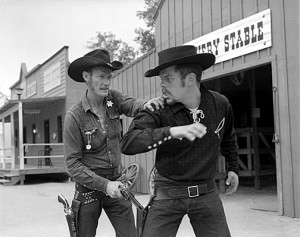What percentage of the time do you think a trader needs to have winning trades in order to be consistently profitable over the long-term? 60%? 70%? 80%?
What if I told you that some of the best equities traders I know have a win rate of only 50%, and some very successful swing and position traders even have a batting average as low as 40%?
If you’re brand new to stock trading, you understandably may find this hard to believe, but I assure you it’s reality. Read on to learn why…
 Naivety Of A Newbie
Naivety Of A Newbie
As a newbie stock trader in the late 1990’s, I was convinced one needed to have a win rate of at least 70-80% in order to make a successful living trading the stock market.
Damn, was I wrong!
On the contrary, such a high percentage of winning trades is not at all necessary in order to rake in trading profits year after year.
But wait, you say. How can a trader or investor who is only netting a gain on 4, 5, or 6 out of every 10 trades still come out a consistent winner in the end?
The answer simply comes down to understanding that…
Profitable Trading Is Only A Numbers Game
To bring home the bacon as a trader, one only needs to ensure that the average gains of one’s winning trades are substantially larger than the average losses of one’s losing trades. Check it out…
Assume a trader buys and sells 10 different stocks and the outcome is as follows:
- 5 winning trades closed with an average gain of $400 each = +$2,000 gain (5 * $400)
- 5 losing trades closed with an average loss of $200 each = $1,000 loss (5 * -$200)
What is the net result of those 10 roundtrip trades with “only” a 50% win rate? A cool net gain of $1,000 (you don’t even need to be a mathematician).
It makes sense, right? It also makes a lot of dollars (sorry, can’t refuse the occasional pun).
Superstar Stock Pickers Not Required
When I eventually realized that consistently profitable trading is merely a numbers game that requires a slight mathematical edge (much like card counting in blackjack), it was fantastic news for me!
It meant that I did not have to be a superstar stock picker, or even a really good one, in order to be a stock market winner.
 Rather, I only needed to develop a trading system that ensured my average winning trades were significantly larger than my average losing trades.
Rather, I only needed to develop a trading system that ensured my average winning trades were significantly larger than my average losing trades.
Over the past 11 years that I have been tracking and reporting the performance of every single stock and ETF swing trade in my Wagner Daily newsletter, my average win rate has only been around 55 to 60%.
However, the dollar amount of my average winning trade to average losing trade has been roughly 2 to 1.
In a strongly trending market, the ratio of average winner to average loser can be even higher.
For example, my average winning stock trade in Q2 of 2016 was +11.15%, while the average losing trade was -4.45%.
This equates to a win/loss ratio of 2.5 to 1 for the quarter (detailed trade stats here).
The great news is that making sure your winning trades are larger than your losing trades is easier than one might assume.
How To Tilt The Edge In Your Favor
Ensuring the necessary mathematical edge for consistently profitable trading only requires the discipline to do three things consistently.
1.) Stay With The Trend Until It’s No Longer Your Friend
When you are holding a trade that is steadily moving in your favor, it is absolutely imperative to let those profits ride as long as the stock or ETF maintains that trend!
In healthy markets, leadership stocks (usually small to mid-cap stocks with strong earnings growth and high relative strength) are driven by the huge momentum and demand of institutional buying.
After a stock breaks out of a valid base of consolidation and enters into a steady trend, that trend typically remains intact for many months, or even years.
Furthermore, the longer a trend has been in place, the more likely that trend is to continue.
That’s why strong stocks trading at new highs are so often seemingly unstoppable.
Spend some time cruising around this blog and you will see many real examples of actual trades where this was the case (you’re bound to learn a thing or two as well).
2.) Know When To Get The Hell Outta Dodge…Without Hesitation!
The second requirement to tilting the trading edge in your favor is to always, without fail, place a predefined protective stop loss immediately after entering each and every new trade.
No matter how bullish a stock chart looks, or how many i-whatever devices a company is expected to sell, or how much your best friend’s wife’s brother insists a stock will rally because of his hot “inside tip,” there will be countless times when the stock plunges of a cliff instead (and remember the actual reason for the price reversal is always completely irrelevant).
 But when you know you have already set your predefined stop loss order immediately after entering the trade, you’ve got nothing to worry about (although the occasional, surprise opening gap from an unpredictable news event sometimes sucks).
But when you know you have already set your predefined stop loss order immediately after entering the trade, you’ve got nothing to worry about (although the occasional, surprise opening gap from an unpredictable news event sometimes sucks).
On the contrary, you should be pleased every time a stock falls to your stop price and you exit the trade with a loss.
Why? Because it means you are maintaining the required discipline to become a consistently successful trader over the long-term.
On the other hand, failing to quickly cut your loss when a trade starts moving too far in the wrong direction inevitably results in pain, heartache, and (if you don’t get your discipline under control) eventually an empty bank account.
Have you ever stayed in a bad romantic relationship too long, rather than simply cutting your losses and moving on?
I have, and (in hindsight) I can assure you that nothing good ever comes out of such a situation. The same is true in trading.
3.) Ensure The Positive Edge With Proper Stop Placement
You now understand the importance of letting momentum work in your favor with winning trades, and the need for getting out quickly when the situation reverses, but the glue holding these two elements together is knowing where to set your initial stop loss price when entering a trade.
Not surprisingly, there are a plethora of technical indicators to assist traders in knowing precisely where to set stop losses.
One method is to set a stop loss just below technical support of a popular moving average (the 20 and 50-day moving averages work well for short to intermediate-term swing trading).
On uptrending stocks, a stop can also be placed just below the prior “swing low” that often creates an anchor point of a trendline.
I personally use both of these techniques because they are simple, yet highly effective.
Nevertheless, I could write an entire chapter of a book dedicated to knowing where to set your stop loss prices (I already have). I could even design an entire stock trading video course with nearly a full hour just on the topic of when to exit your trades (I’ve done that as well).
The “Quick And Dirty” Method For Setting Stops
Even if you know absolutely nothing about technical analysis, and barely know how to read a stock chart, here’s a great guideline for setting stops that will keep you and your trading account out of harm’s way.
 For the types of stocks I trade (higher volatility than old school Dow-type stocks), one can simply set a stop price that is no more than 7-8% below the entry price.
For the types of stocks I trade (higher volatility than old school Dow-type stocks), one can simply set a stop price that is no more than 7-8% below the entry price.
If, for example, the stock price is $50 at the time of entry, an 8% stop would equate to a stop loss price no lower than $46 ($50 * 8% = $4 stop).
For extremely high beta stocks ($TSLA is a good example), I use a wider stop. For most ETFs, on the other hand, I use tighter stops because many (but not all) of them have lower volatility.
How do I know that 7-8% is the right ballpark figure for most stops on the stocks I trade?
Well, that brings me full circle back to the beginning of this article.
I only need to make sure that the percentage gain of my winning trades is expected to be at least twice the percentage loss of my losing trades.
This is known as a reward-risk ratio, and the minimum ratio I always aim to achieve is 2 to 1.
This means my expected potential reward (the amount I will gain on the trade if it hits the area of my target) should be at least double my risk (the amount I will lose if the trade hits my goes the wrong way and hits my stop).
Since most momentum-based stock breakouts rally at least 15-20% (sometimes much higher) before stalling or taking a rest, using a stop price level of 7-8% leaves me with a typical reward-risk ratio of 2 to 1.
Get it? Got it? Good.
If you’re still with me at this point of the article, congratulations because it means you are serious about improving your trader education to succeed as a momentum swing trader or investor.
Trying to count the number of mistakes I made when I was a new trader would surely give me a headache. Even now, occasional mistakes are unavoidable.
But in my heart, I truly believe you can screw up a lot of things in trading, yet still be net profitable when the dust settles IF you simply focus on always putting the mathematical edge in your favor.
As investing legend George Soros once said, “It’s not whether you’re right or wrong that’s important, but how much money you make when you’re right and how much you lose when you’re wrong.” We couldn’t agree more.
If this article inspired you or gave you some good for thought, please share with your favorite social network by clicking icon on the left and drop us a comment below. Thanks!
Since 2002, our swing trading service has helped thousands of traders increase their trading profits, while learning “no nonsense” trading methods that work. Sign up for your 30-day risk-free subscription today.

Interesting concept and knowledge you shared here, thanks for that 🙂
You have to research a lot into the stock trading to do well (:
That’s true. Hard work and dedication to scan for the best stocks to buy cannot be avoided.
Just found your site. You know what I like about you? How damn simple you make it. I guess it doesnt have to be complicated with hundreds of indicators. As a newbie, I find your blog refreshing and it relates to my personality as a way I think I want to trade. It seems all of the good traders have one thing in common. They cut their losses short.
Thank you for sharing your expertise and insight.
Hi Todd,
Thanks for the kind words.
Really happy that you are discovering the beauty of simplicity in trading. It certainly reduces the stress levels, which ultimately prevents burnout.
Appreciate your enthusiasm.
That is a great post and explained in a very simple way.
I have one question : Should the stop loss amount be same in all the trades ? For example, if one is trading on a $100 share and has the stop loss at 3% which is $97 against an expected gain of 6% for a 1:2 risk reward ratio. But, if he is trading on a $400 stock, 3% comes down to $412 against an expected upside of 6% which is $424. Many such heavy stocks don’t move to this extent in one trading session. Moreover, one loses more money if 3% stop loss is hit on the $400 share compared to 6% gain on the smaller value stock.
So, this would disturb the risk reward ratio. How should this be handled ?
Thanks!
Hi, sorry for the late response. It is best to keep the dollar loss constant when trading the same type of setup. For example, our best setups occur when a stock is breaking out from a strong base. We like to put size on before the base breakout and add the rest at the breakout. For this type of trade we may risk 1% of account equity. However, say in two weeks, the same stock offers a pullback entry off support at the 20-day MA, then we might only risk .5% of capital on the trade, because it is extended from the base breakout. I hope this helps, if you have any other questions please let me know. Thanks
Also, If you are new to trading and do not know which setups carry more risk than others, I would suggest trading all setups with the same percent risk of account equity. Thank you again, I hope this helps.
Good Read 😀
Thanks, glad you liked it.